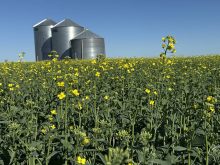Fed cattle prices rise
Tight supplies continue to increase the feedlot bargaining position.
Fed steers were $3.50 per hundredweight higher than the previous week
and heifers were up $2.50.
Canfax said the increase in Canadian cash trade coupled with steady
money in the United States pushed the Alberta steer average for the
week to a 25 cents per cwt. premium to the U.S. cash market with the
higher end of the range at a larger premium.
All the trade reported was to western Canadian buyers.
Read Also

Huge Black Sea flax crop to provide stiff competition
Russia and Kazakhstan harvested huge flax crops and will be providing stiff competition in China and the EU.
Alberta prices Jan. 10 were steers $105.25-$109.25 per cwt., flat rail
$177-$178.35 and heifers $104.75-$106.75, flat rail $177-$179.25.
Beef prices increase
Wholesale beef prices also gained some ground.
The Montreal price this week is up $2-$3 at $171 per cwt.
The Calgary market is up $3-$5 on the regular weights with steers at
$168-$181. Heavy cattle numbers are becoming more manageable. They are
up $2-$3.50 at $165-$167.
Retailers are still reluctant to buy large supplies of beef, with some
mentioning Lent just around the corner.
Canfax expects tight fed cattle supplies and steady prices will
continue for the next few weeks, but prospects for stronger prices are
limited until the American cash trade moves higher to give the Canadian
market support.
Canadian plants may reduce kills to help manage the higher cash trade
and poor beef movement.
Feeder trade was more active but still slower than the same week last
year.
Steer averages were mostly $1.25-$1.50 per cwt. higher and heifers
mostly $1-$3.50 higher, said Canfax.
Due to smaller volumes, feeder price increases and tighter ranges have
been dependent on quality.
Strong prices have been reported on lighter grass calves at some
markets.
Total volume reported was 47 percent smaller than the same week last
year.
Slaughter cows traded $1.25 per cwt. lower on increased volumes.
Canfax said the wide feeder basis should increase feeder exports as
the year progresses.
The basis on 850 lb. steers historically does not get much wider than
it is now, indicating that prices may be close to a low.
If exports start increasing and the U.S. sets the Canadian feeder
cattle floor, prices should hold steady and may start to increase
slowly over the next month.
The stock cow trade was in a post holiday slowdown.
A few bred cows were sold at $800-$1,450 with most at $1,150-$1,450.
Bred heifers were $900-$1,125.
There were no cow-calf pairs reported.
U.S. hog prices drop
American meat retailers offered more pork specials last week to help
move product.
Normally at this time of year prices begin to strengthen, which
probably encouraged retailers to buy from packers.
However, supplies of pork, beef and poultry remain plentiful.
Due to large supplies, packers were reluctant to pay more for hogs last
week.
The Iowa-Minnesota daily direct hog price (mean, 51-52 percent lean,
live equivalent) declined from $39.58 US per cwt. on Jan. 7 to $38.82
on Jan. 10.
On average, the week’s U.S. hog price was two percent lower than the
week before.
Because of the nature of producer contracts, American hog price changes
take a week to appear in Canada. Prices north of the border were up,
reflecting the previous week’s strength in the U.S.
















